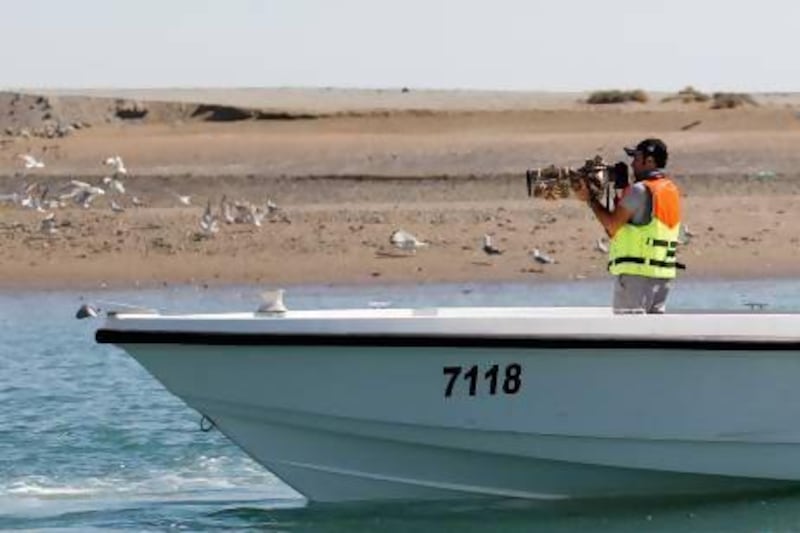It is late afternoon and a group of men are enjoying a round of golf, wheeling their clubs behind them as they play at Abu Dhabi City Golf Club.
As they chat among themselves, they are oblivious to Oscar Campbell, a secondary school science teacher, standing in the undergrowth nearby dressed head to toe in green, scanning the course with a pair of binoculars and a powerful telescope perched on a tripod.
But Campbell is not interested in the golfers; the focus of his attention is three species of birds nestled around a rock in the middle of a small pond.
"Look, there's a couple of lapwings," he says, pointing out two red-wattled lapwings, a common sandpiper and a striated heron more often seen in Abu Dhabi's Eastern Mangroves.
"The lapwings are resident here and are a good example of a bird that is getting commoner as greenery appears," says Campbell.
"The common sandpiper nests in northern Russia and northern Europe and then spends the winter here, but the heron nests in the Eastern Mangroves. It may have come here because the feeding is good, for a few weeks, and then it will go back."
Campbell is certainly the person to know. As chairman of the Emirates Bird Records Committee (EBRC), a voluntary organisation that monitors bird numbers in the UAE, he spends most of his spare time birdwatching.
A popular hobby in many parts of the world - there are believed to be more than 50 million birdwatchers in the United States and large numbers in the United Kingdom and Europe - here, in the UAE, it is more of a niche pastime.
According to Tommy Pedersen, who runs UAEbirding.com, there are 25 keen birdwatchers here, with less than 10 of those considered "twitchers" - committed birdwatchers who are willing to travel long distances to find new species to add to their list.
"Birdwatching is a boy thing," says Pedersen, 49, an airline pilot who goes "birding" all over the world thanks to his job. "When boys grow up they collect stamps, coins or bottle caps, but for me it was birdwatching. Instead of stamps, you collect species that you've seen - it's a collecting thing."
Both Pedersen and Campbell fall into the "twitcher" category.
Both avid birdwatchers from a young age, the Norwegian Pedersen scoured the forests of Oslo for new species while Campbell, 38, spent his teenage years recording birds in the countryside of his native Northern Ireland.
"I got my first bird book and telescope when I was 12 and would document the birds I saw. I've got books going back 28 years," says Campbell, who moved to the UAE six-and-a-half years ago partly because it was a great location to indulge his passion.
"It's exciting here because you regularly find something different, because it's a migration crossroads and there are relatively few birdwatchers.
"The summer is a bit quiet because of the heat but, from September to May, there is plenty going on, particularly during the migration season, which runs from mid-August to December; and then there's spring migration from early March to the middle of May.
"The UAE is also a great location to get to other places; I've been to India, Thailand, Kenya, Borneo, Indonesia and South Africa from here to see birds," he says.
But with about 450 species of birds to see in the Emirates - of which 90 to 100 actually breed, while the rest are either migrants or winter visitors - it is here that Campbell and his fellow twitchers focus their attention.
With spring migration about to begin, the birders will be looking out for species such as the greater spotted eagle, crab plover, white-tailed lapwing, desert lark and Hume's wheatear (all pictured on Weekend's cover).
They visit birdwatching sites across the nation and, such is their enthusiasm to find rare breeds, that no place is off-limits - not even sewage treatment plants, as the nutrients and flies attract large numbers of birds.
But wherever the birders go, they are armed with the essential birdwatching tools: a bird book, camera, binoculars, tripod and telescope, MP3 player loaded with bird songs to attract birds and sometimes even a camouflage tent.
But most important of all is a notebook, because the key to birdwatching is keeping a list.
Check out UAEbirding.com's Club 300, a section detailing the total number of UAE birds spotted by "top listers" - 21 bird watchers who have seen more than 300 species. There are two elite birders who have secured a Club 400 mention with sightings of 414 and 411.
While Pedersen, who has lived here for 11 years, has seen 377, Campbell has seen 363.
"There is an element of competition: I'm not particularly competitive but some people are. But it's much more competitive in Britain," says Campbell.
"We're all trying to get past 400," laughs Pedersen, who goes out birdwatching with his wife and two sons, ages 5 and four months. "The birds I'm trying to see now are quite rare. Tomorrow I'll go and look for a crow in Umm Al Quwain, because it's never been seen in the UAE before.
"I stand a 10 per cent chance of seeing it, but I'll bring my family and we'll make a picnic and take a few hours to see that one bird."
While Pedersen's and Campbell's tallies are admirable, Khalifa Al Dhaheri, one of four avid Emirati birdwatchers, is hot on their heels with 337 on his UAE list.
A keen photographer, Al Dhaheri took up the hobby in 2009 when he met a bird photographer and was mesmerised by his pictures.
"You can do it whenever you have free time," says the 30-year-old assistant analyst for an oil company, who divides his time between his work in Jebel Dhanna and homes in Ajman and Al Ain.
"I go on dedicated trips to Sila or farms in Dibba or take an hour after work - I have counted 190 birds for my Jebel Dhanna list."
Last weekend, Al Dhaheri and some fellow birders took a boat out from Khor Kalba on a seabirding mission - a regular trip that any birdwatcher can join.
"The boat travels out to deep water looking for flocks of birds feeding on fish. One time I saw the highest count of flesh-footed shearwater. There were more than 38 to 70 together, which is rare to see," says Al Dhaheri.
"If I see something really rare, I get really excited. I have scored four first records so far, including a Cory's shearwater - a bird that usually follows a migratory route in West Africa towards Europe - so to see it here is very rare."
The birders record their sightings on UAEbirding.com, which features national checklists of birds, popular sites to visit and a forum for members to post sightings and ask questions, to ensure the group maintains an accurate database of records.
Anyone who spots a rare bird must submit a rare bird report for approval by the EBRC.
"There was one bunting that Oscar saw, which might or might not be a new species for the UAE, and we have pictures of it but still the jury is out because we are looking at very very fine details," says Pedersen, who first launched the site in 2005.
But the website is not just aimed at UAE; it also acts as an information portal for tourist birdwatchers.
Pedersen and Campbell, along with other "diehard" birders, guide groups to popular sites, charging up to Dh1,400 for a full-day of birdwatching.
And, it is not just hard-core birdwatchers that they want to attract; the group also wants to encourage beginners to take up the hobby. Because the more people posting sightings, the easier it is to measure which species are declining - something that is key in such a fast-developing nation.
"We are essentially an amateur effort to disseminate information, but a lot of the information we collect has interesting scientific value and there are some things that are relatively recently discovered," says Campbell, who also carries out annual bird counts at internationally valued UAE sites as part of a global count to monitor bird populations.
"In the long-term, if habitats support a certain number of birds and habitats are declining, that means that bird populations are declining.
"So a big part of what we do is about conservation, and the more people that are interested the better."
While the birdwatchers have a mission to raise awareness of dwindling bird populations, the main aim of their hobby is relaxation.
At Abu Dhabi City Golf Club, Campbell has spotted a common kestrel on top of a pylon.
"I come here before heading home after work because it's a good way to wind down," he says. He admits his hobby takes up a lot of time, something his fiancee, also a teacher, isn't always keen on.
"She's not a birdwatcher and she knows a lot more about birds now than she did when she met me. She's also seen some interesting birds that would make a lot of bird watchers envious, but she's certainly not that keen on going to sewage works.
"For me birdwatching is a like being a hard-core football supporter. Those guys travel all over the country, often in groups of friends, and they've no control over the outcome whatsoever."
Follow us
[ @LifeNationalUAE ]






